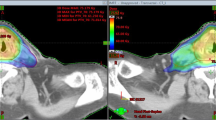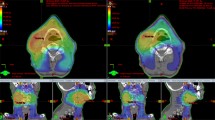Background:
Tumor doses > 70 Gy are needed for local control in adenoid cystic carcinomas. These tumor doses cannot be delivered if the tolerance doses to neighboring organs at risk (OAR) are respected. This treatment planning study investigates the physical advantage of combined photon intensity-modulated radiation therapy (IMRT) plus carbon ion boost compared to photon IMRT alone.
Patients and Methods: For nine patients, treatment plans were generated using a) photon IMRT alone (integrated boost concept), and b) sum plans consisting of a photon IMRT plan and a carbon ion boost plan. 54 Gy were prescribed to the planning target volume 1 (PTV1), the boost volume (PTV2) received 72 Gy. The tolerance doses of the delineated OAR were strictly adhered to. Plan quality of IMRT plans and sum plans was compared using adequate physical parameters.
Results: Both therapy techniques lead to highly conformal dose distributions that allow the prescription of the desired target doses. Target conformality and heterogeneity as well as target coverage for PTV1 are comparable for both techniques. The target coverage for PTV2 can be significantly improved using carbon ion beams (median 95% coverage 93.7% vs 87%; p = 0.039). Furthermore, the mean doses to the OAR can be reduced by 8.3% (median % reduction of mean doses to OAR; p = 0.00001) using carbon ions.
Conclusions: The combination of photon IMRT with carbon ions improves the target coverage for the boost volume and offers better sparing of OAR close to the PTV2 (gross tumor volume) in comparison with photon IMRT alone. A clinical study has been initiated to evaluate whether these potential advantages translate into clinical benefit.
Hintergrund:
Für die lokale Kontrolle adenoidzystischer Karzinome werden Tumordosen von > 70 Gy benötigt. Derart hohe Dosen lassen sich unter Einhaltung der Toleranzdosen von benachbarten Risikoorganen häufig nicht erreichen. Im Rahmen dieser Planvergleichsstudie sollen die physikalischen Vorteile einer kombinierten intensitätsmodulierten Radiotherapie (IMRT) mit Kohlenstoffionenboost gegenüber alleiniger IMRT mit integriertem Boost untersucht werden.
Patienten und Methodik: Für neun Patienten wurden Bestrahlungspläne für a) die alleinige Photonen-IMRT (integrierter Boost) sowie b) Summenpläne, bestehend aus Photonen-IMRT und Kohlenstoffionenboost, generiert. Das Planungszielvolumen 1 (PTV1) erhielt eine Dosis von 54 Gy, das Boostvolumen (PTV2) eine Dosis von 72 Gy. Die Toleranzdosen für die Risikoorgane wurden strikt eingehalten. IMRT-Pläne und Summenpläne wurden anhand geeigneter physikalischer Parameter bezüglich ihrer Qualität verglichen (Tabelle 2).
Ergebnisse: Mit beiden Techniken lassen sich hochkonforme Bestrahlungspläne erzeugen, die die Applikation der verschriebenen Tumordosen erlauben (Abbildungen 1a und 1b). Für das PTV1 sind Zielvolumenheterogenität und -konformität vergleichbar (Abbildungen 2 und 5, Tabelle 3). Die Zielvolumenerfassung des PTV2 ist bei Verwendung von Kohlenstoffionen jedoch signifikant besser (mediane 95%-Erfassung 93,7% vs. 87%; p = 0,039; Abbildungen 3 und 4). Des Weiteren können die mittleren Risikoorgandosen bei Verwendung von Kohlenstoffionen um 8,3% gesenkt werden (mediane prozentuale Reduktion; p = 0,00001).
Schlussfolgerungen: Die Verwendung von Kohlenstoffionen in Kombination mit Photonen-IMRT ermöglicht im Vergleich zur alleinigen IMRT eine bessere Erfassung des Boostvolumens sowie eine bessere Schonung von dem PTV2 benachbarten Risikoorganen. Inwiefern diese potentiellen Vorteile zu einem klinischen Nutzen führen, wird derzeit im Rahmen einer klinischen Studie überprüft.
Similar content being viewed by others
Author information
Authors and Affiliations
Additional information
Received: July 15, 2002; accepted: November 14, 2002
Correspondence Address Daniela Schulz-Ertner, MD, Department of Radiation Oncology, University of Heidelberg, INF 400, 69120 Heidelberg, Germany, Phone (+49/6221) 56-8201, Fax -5353, e-mail: d.ertner@dkfz.de
Rights and permissions
About this article
Cite this article
Schulz-Ertner, D., Didinger, B., Nikoghosyan, A. et al. Optimization of Radiation Therapy for Locally Advanced Adenoid Cystic Carcinomas with Infiltration of the Skull Base Using Photon Intensity-Modulated Radiation Therapy (IMRT) and a Carbon Ion Boost. Strahlenther Onkol 179, 345–351 (2003). https://doi.org/10.1007/s00066-003-1071-7
Issue Date:
DOI: https://doi.org/10.1007/s00066-003-1071-7




